Abstract
Energy hub stations represent a transformative approach to modern energy systems, functioning as flexible nodes within distribution networks. By seamlessly integrating electric vehicles (EVs) and battery energy storage systems (BESSs), these hubs address critical challenges such as grid stress, renewable energy utilization, and peak load management. This study introduces a novel mathematical optimization model designed to maximize the operational flexibility of EV charging stations by transforming them into fully functional energy hubs. The model incorporates key parameters such as energy demands, load profiles, and grid conditions to optimize the sizing and operation of distributed energy resources, including photovoltaic (PV) systems and BESSs. The proposed approach minimizes grid dependency, enabling energy hubs to efficiently operate varying levels of operational flexibility, from full reliance on grid power to complete independence. The results reveal that, by effectively shifting energy usage away from peak periods and leveraging PV generation, energy hubs emerge as a critical component of sustainable energy systems and can independently support approximately 45% of their load, with minimal PV and BESS capacities. It also reveals a direct correlation between higher flexibility levels and increased infrastructure requirements for PV systems and BESSs. The proposed model underscores the critical role of energy hubs in facilitating the global shift toward decarbonization, aligning with contemporary goals for resilient and environmentally sustainable energy ecosystems. This work provides a scalable framework for future energy systems, with significant implications for policymakers, researchers, and practitioners in the fields of renewable energy and sustainable mobility.
1. Introduction
The global transition to renewable energy sources and electric mobility is critical for sustainable development. Electric vehicles (EVs), as a green transportation alternative, align with environmental and economic objectives, including Saudi Arabia’s Vision 2030 [1]. However, the integration of EVs into the energy grid presents challenges such as increased peak load and grid reliability concerns. Addressing these issues necessitates innovative infrastructure solutions, particularly in the form of energy hubs [2].
An electric vehicle charging energy hub can be defined as a multi-functional infrastructure that integrates EV charging systems with energy management and storage technologies. It combines renewable energy sources such as photovoltaic (PV) generation, battery energy storage systems (BESSs), and smart energy management to ensure efficient and sustainable EV charging. Such a design of an EV charging station renders it an EV charging energy hub, providing flexibility to the distribution system and deferring upgrades [3]. This paper provides a comprehensive framework for transforming conventional EV charging stations into EV charging energy hubs, emphasizing their role in sustainable energy ecosystems.
The growing integration of EVs into the power grid has become a crucial area of research, with numerous studies exploring various aspects of this challenge through stochastic models and planning approaches. The studies generally focus on optimizing charging strategies, evaluating the impact of EVs on distribution networks and addressing the uncertainties involved in EV adoption and charging demand. The risks associated with the integration of EVs into residential distribution networks was highlighted in [4], stressing the importance of managing voltage behavior, unbalance, system losses, and thermal transformer limits to ensure reliable RDN operation. The authors of [5] emphasized the design of large-scale EV charging sites and their role in accelerating EV adoption. They propose a stochastic model to predict EV arrival patterns and power demand, which aids operational decisions, collaboration with grid operators, and investment planning. A two-stage stochastic programming model to design a public EV charging station network was introduced in [6]. This model accounts for uncertainties in various factors and shows that while more charging stations improve accessibility, they may reduce station utilization, influencing policy decisions. A method was developed in [7] to analyze EV charging demands using stochastic simulation of trip chains, offering insights that help optimize power system infrastructure. The authors of [8] proposed a Monte Carlo simulation-based stochastic approach to estimate the load demand of domestic plug-in EVs. This approach aids distribution system planning, load management, and infrastructure sizing. Ref. [9] presented a two-stage stochastic programming model for optimizing charger allocation and EV flow distribution, outperforming other methods in simulations for Massachusetts highways. A decentralized algorithm for optimal EV charging was introduced in [10], considering elasticity and formulating the problem as an optimal control issue, ensuring that optimal charging profiles are achieved despite varying EV specifications. The partition-based random routing strategy for EV charging systems with stochastic demand was proposed in [11]. This flexible routing policy effectively reduces response times and adapts to dynamic charging demand. The load profile of fast-charging stations for EVs was modeled in [12], incorporating traffic flow and EV efficiency, using Monte Carlo simulations and real-world Norwegian data to enhance planning. The potential of using parked EVs in parking lots was examined in [13] as grid energy storage; a stochastic model was proposed to assess various EV behaviors and their ability to serve as energy resources for the grid. The authors of [14] developed a stochastic planning model for an EV charging station that incorporates distributed energy sources. Their model seeks to minimize the station’s total cost by accounting for uncertainties in charging demand and photovoltaic (PV) power generation.
Effective energy management within EV charging energy hubs is critical to balancing energy supply and demand. A hierarchical energy management system integrating plug-in EVs into home-energy hubs was proposed in [15], ensuring the efficient utilization of resources while minimizing costs and emissions. Similarly, probabilistic models were introduced in [16], for optimizing PHEV charging within renewable-based hubs, addressing uncertainties in energy supply and vehicle demand. Renewable energy sources like solar and wind are often integrated into EV charging energy hubs. The authors of [17] explored cooperative energy management for EV hubs powered by photovoltaics (PVs) and storage systems, highlighting the importance of harmonizing energy flows. Ref. [18] demonstrated the potential of optimal hub scheduling for providing grid services, reducing reliance on conventional power sources, and mitigating grid congestion. The influence of charging strategies on the sizing of storage systems in microgrids was studied in [19], identifying methods to align charging patterns with renewable availability. IoT-enabled operations were explored in [20], for multi-energy hubs, focusing on demand response and dynamic charging schedules to minimize grid impacts. The authors of [21] introduced a probabilistic framework for assessing the economic and technical performance of EV charging energy hubs, considering varying charging strategies and grid interconnections. Simulation and optimization tools were critical in evaluating EV charging energy hubs’ performance. Multi-agent simulations were carried out in [22] to assess the impact of EV penetration and charging behaviors on energy hub operations. Ref. [23] developed robust models for integrating thermal and electrical demand response programs, enhancing hub resilience under different charging modes. The spatial optimization of charging infrastructure, focusing on public transportation systems in urban areas, was addressed in [24]. This research provides insights into planning and policy requirements for supporting sustainable mobility.
Unlike previous studies, this study incorporates varying levels of flexibility to optimize the sizing and operation of distributed energy resources (DERs), such as PV systems and BESS, reducing grid dependency and managing peak loads. The main contributions of the paper are as follows:
- Proposes a novel mathematical optimization model designed to enhance the operational flexibility of EV charging stations by transforming them into EV charging energy hubs, focusing on the optimal sizing and operation of distributed energy resources (DERs), such as photovoltaic (PV) systems and battery energy storage systems (BESSs).
- Examines the effects of different levels of flexibility requirement on DER capacity needs and hence provides critical insights into the planning and design of future energy systems to support sustainable and resilient energy ecosystems.
- The proposed design of EV charging energy hubs enables operation with varying levels of grid independence, ranging from complete reliance on the grid (0%) to full autonomy (100%). This flexibility substantially decreases dependence on the central grid, representing a significant advancement toward achieving more sustainable and resilient energy systems.
- Incorporating EV charging stations with varying levels of flexibility into distribution systems can effectively mitigate grid stress, enhance renewable energy utilization, and improve peak load management.
2. Proposed Mathematical Optimization Model
The proposed mathematical optimization model is designed to meet flexibility requirements in EV charging energy hubs by incorporating several key features and principles, as follows:
- The proposed model enables EV charging energy hubs to operate at different levels of grid reliance, from complete dependence to full autonomy (0% to 100% flexibility). This adaptability ensures that the hubs can respond dynamically to grid conditions, reducing stress and supporting stability in the distribution system.
- By optimizing the sizing and operation of PV systems and BESSs, the proposed model ensures efficient energy management. This allows the hubs to store surplus energy, utilize renewable sources, and shift loads away from peak periods, aligning with the demand for flexibility.
- The proposed model accounts for energy demands, load profiles, and grid conditions, enabling energy hubs to adjust operations based on real-time requirements. This adaptability enhances their ability to meet flexibility demands and support grid resilience.
In summary, the proposed model transforms EV charging stations into adaptable energy hubs, capable of meeting diverse flexibility requirements while contributing to grid stability, operational efficiency, and sustainability goals.
- Objective Function: Minimize the capacity size of distributed energy resources associated with an EV charging station energy hub, such as PV generation and (BESSs) as given by:
- Demand–Supply Balance: Total generation should meet the demand at period h on a typical day, as follows:where .
Battery Energy Storage System Constraints
The relationship between the charging and discharging power of the BESS and its SOC can be described as follows:
The energy capacity of the BESS for a certain power rating is determined based on its energy-to-power ratio, as follows:
The initial SOC state (hour 1) and the final state (hour 24) of the BESS is assumed to be 50% of the installed energy capacity, as follows:
In order to prevent simultaneous charging and discharging, the following constraint is included as follows:
- Grid Dependency Constraint: The grid power contribution is capped at a predefined maximum, as follows:
- Energy-to-Power Ratio of BESS and Maximum Discharge Time: Each battery technology has a specific range of energy-to-power ratios and maximum discharge times. The range of the energy size for a specific power size is thus constrained as follows:
- Flexibility Requirements: The flexibility level, a core feature of the proposed model, governs peak load management.
- Peak Load Constraint: The following constraint ensures that the peak load is minimized, in conjunction with (1).
- Flexibility Provision Constraint: This constraint ensures that the peak grid load is reduced by a factor proportional to the flexibility . The higher the flexibility, the less energy the station draws from the grid during peak demand periods. It allows for flexibility in the system’s operation while ensuring that the energy hub remains within feasible limits based on the energy resources available (like PV and BESS).
This constraint is vital for minimizing grid dependency, managing peak loads, and optimizing the performance of energy hubs as flexible nodes within the smart grid. It directly impacts how the hub balances its internal generation (from the PV system) and storage (from the BESS) against its reliance on grid power, particularly during times of peak demand.
The above proposed framework is programmed using the General Algebraic Modeling System (GAMS) environment [25].
3. Input Data and Simulation Results
3.1. Input Data
The analysis is conducted considering a 32-bus radial distribution system [26]. This system’s highest demand is 3.8 MW, and it operates at a base voltage of 12.66 kV. Load profiles for this study are sourced from the IEEE Reliability Test System [27], with all loads characterized as residential. The peak demand per household is estimated to be 2.08 kW [2], used to project the number of residences per bus. Data from the NHTS [28] estimated an average of 1.9 vehicles per residence, aiding in the calculation of the total number of EVs given the EV penetration rate [2]. EV station load profiles modeled in [29] are adopted in this study by considering several specific assumptions, as follows:
- It is posited that EVs maintain a battery state of charge within a 70% range, from 20% to 90%, to optimize battery usage and charging opportunities.
- EVs are expected to begin their daily operations fully charged from an overnight charge at home, eliminating the need for additional charging before commencing a trip. This situates fast charging as an ancillary option to home charging.
- The analysis focuses on data involving 850,000 trips and 150,000 vehicles culled from a broader NHTS dataset initially containing about 1,000,000 trips and 300,000 vehicles. The focus narrows to specific types of vehicles, excluding records with incomplete data to improve study precision.
- The research includes EVs categorized as EV20, EV40, and EV60, representing compact sedans equipped with batteries of 6.51 kWh, 10.4 kWh, and 15.6 kWh, respectively, capable of covering 20, 40, and 60 miles on a single charge.
- To optimize the study’s computational resources, vehicles that traverse less than 20 miles daily are omitted from the fast-charging demand analysis as their charging needs are minimal and do not substantially influence the demand calculations.
3.2. Results and Discussions
Using the proposed mathematical model, the design of EV stations is evaluated across a spectrum of scenarios, ranging from the station functions as a conventional EV charging facility dependent solely on grid power (0% flexibility), to the station operates entirely on power from BESS and PV systems, with no reliance on the grid (100% flexibility).
3.3. Impact of Flexibility Levels on DER Sizing and Capacity
Figure 1 shows the relationship between the flexibility requirement level in reducing EV station peak loads, expressed as a percentage, and the power size of PV generation. It illustrates how increasing requirements for flexibility in an energy system impact the needed capacity of PV generation. At lower levels of flexibility requirements (from 0% to about 30%), the power size of PV generation remains relatively low. This suggests that when flexibility demands are minimal, there is less need for substantial PV generation capacity to meet energy needs or system stability. As the flexibility requirement increases to moderate levels (40% to 60%), there is a noticeable increase in the required power size of PV generation. This part of the curve shows a steeper ascent, indicating that more significant PV capacity is needed to handle intermediate levels of flexibility in the system. At high levels of flexibility (70% and above), the power size of PV generation increases substantially, exhibiting the highest values on the chart at 90% and 100% flexibility requirements. The very steep rise between 70% and 100% suggests that very high flexibility demands necessitate a disproportionately larger PV capacity. It can be noted that there is a direct and increasingly demanding relationship between the level of flexibility required by an energy system and the capacity of PV generation needed.
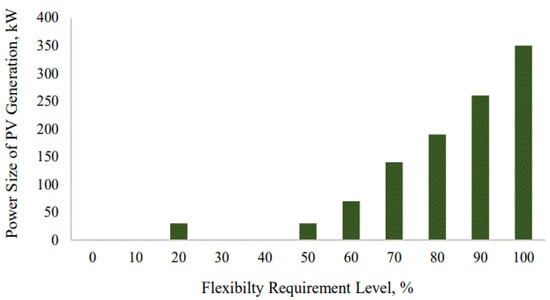
Figure 1.
Optimal power size of PV generation considering different levels of power flexibility.
Figure 2 and Figure 3 present the relationship between the flexibility requirement level and the corresponding BESS power and energy capacity, illustrating how the need for energy storage capacity increases with the flexibility demands of an energy system. With flexibility levels ranging from 0 to 20%, the BESS capacity is minimal, showing that low flexibility demands can be met with a smaller scale of energy storage. As the flexibility requirement increases to 30% and 50%, there is a notable rise in BESS capacity, indicating a direct relationship where increased flexibility demands result in a greater need for energy storage. It is also observed that there is a consistent increase in BESS capacity as the flexibility requirement levels increase from 40% to 70%. The linear progression suggests that each step up in flexibility requirement continues to necessitate a proportional increase in BESS capacity. In the highest category, from 80% to 100%, the power and energy capacity of the BESS surges dramatically, which highlights the critical need for substantial energy storage to manage the highest levels of flexibility, due to peak load management and/or integration of intermittent renewable energy sources. It can be concluded that the capacity requirements for BESS increase progressively with the level of flexibility required by the energy system. This indicates a robust correlation between the ability to manage variable loads and the necessity for larger energy storage solutions. The sharp increase in BESS capacity at very high flexibility levels underscores the challenges and demands placed on energy systems that need to be highly adaptable and responsive to changes in energy production and consumption.
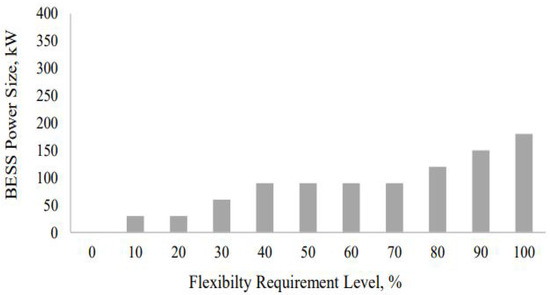
Figure 2.
Optimal power size of BESS considering different levels of power flexibility.
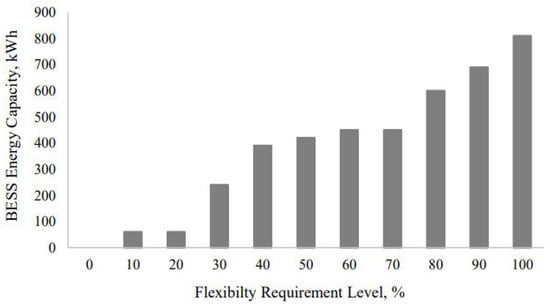
Figure 3.
Optimal energy capacity of BESS considering different levels of power flexibility.
Figure 4 illustrates two key metrics, the capacity of DER and the peak load on the grid from EV charging stations, as functions of the flexibility requirement level, which ranges from 0% to 100%. At 0% flexibility, the load demands of EV stations are entirely supplied by the main grid. In contrast, at 100% flexibility, the load is completely supported by the DER, rendering the station independent from the main grid. It is noted that there is a nonlinear increase in DER capacity as the flexibility requirement level increases. Starting relatively low, the growth in DER capacity is modest up to about 50% flexibility, after which it accelerates significantly, suggesting an exponential growth pattern. This increase reflects the integration of additional DER capabilities like solar resources to meet higher flexibility demands, essential for managing variability in renewable energy generation and consumption. The peak load attributable to EV charging stations on the grid starts higher than the initial DER capacity and decreases linearly as the flexibility requirement level rises. The steep rise in DER capacity at higher levels of flexibility requirement suggests that substantial investment in DER is considered vital for enhancing grid flexibility. This could be driven by the need to ensure grid stability, provide local energy generation, and reduce transmission losses. The exponential growth highlights the challenge and necessity of scaling up DER to manage peak loads and integrate fluctuating renewable energy sources effectively.
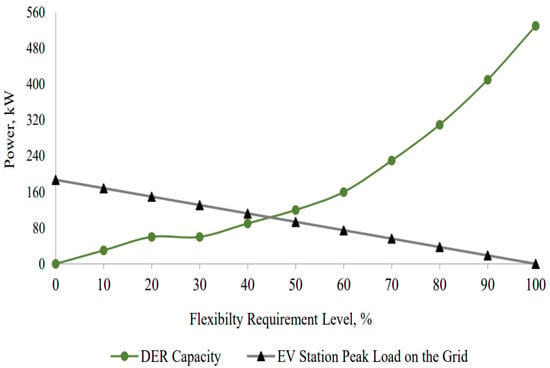
Figure 4.
Optimal DER capacity vs. EV station peak load reduction, considering different flexibility requirements.
It should be mentioned that higher flexibility levels require larger BESS and PV capacities, which entails higher initial investment costs. However, this reduces grid dependency and enhances operational efficiency. Flexibility scenarios demonstrate the potential to shift energy consumption away from peak demand periods, easing the load on the grid and delaying costly infrastructure upgrades, and the EV station can sustain approximately 45% of its load with minimal DER capacity.
While the current analysis primarily focuses on illustrating the relationship between flexibility requirements and DER capacity, incorporating a detailed discussion on the economic implications would significantly enhance its value. Future work will include a cost-benefit analysis to evaluate the advantages, such as reduced grid dependency, improved peak load management, and enhanced renewable energy utilization, in relation to the costs associated with increased DER capacity. This approach will provide a clearer understanding of the optimal balance between achieving flexibility and managing investment costs, thereby offering a more comprehensive framework for decision-making. Additionally, a discussion on the associated trade-offs will be included to identify scenarios where pursuing extreme flexibility levels may not be economically viable, thus providing actionable insights for policymakers and stakeholders.
3.4. Load Profiles and Grid Implications Under Different Flexibility Scenarios
Different EV charging station load profiles on the grid over a 24-h period considering three scenarios: 0% flexibility, 50% flexibility, and 90% flexibility, are presented in Figure 5, Figure 6, and Figure 7, respectively. Each load profile illustrates a distinct pattern of energy consumption by EV stations, which can have significant implications for grid management and operational strategies. With 0% flexibility, the EV station load starts at a moderate level, gradually increasing through the morning and afternoon, peaking in the late evening hours, and then declining sharply overnight. This profile indicate high use during typical peak hours (EV station peak load reaches up to 210 kW), which could coincide with peak residential or commercial electricity demand, thus adding significant stress to the grid. When 50% flexibility is considered, the EV station load profile begins low, rises sharply in the morning, drops significantly mid-day, then increases again in the evening before leveling off during the night. The peak load of the EV station is at about 105 kW, and the load curve has moderate variability with a significant drop in mid-day demand, which might offer the grid some relief during typical mid-day peak periods but requires the grid to manage sharp ramps in demand, whereas, with 100% flexibility, the EV station load shows a flat load profile throughout the day, and the peak load is consistent at about 40 kW. This profile indicates a steady demand on the grid, which is easiest to manage from a grid operation perspective as it avoids sudden spikes in power requirement and allows for more predictable energy provision.
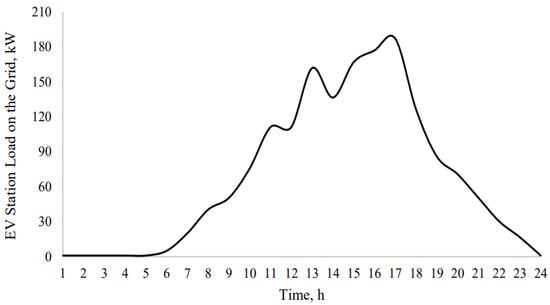
Figure 5.
EV charging station load profile on the grid considering 0% flexibility scenario.
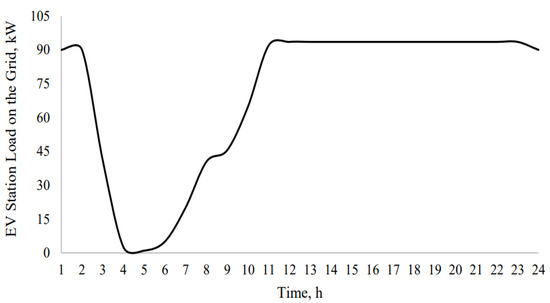
Figure 6.
EV charging station load profile on the grid considering 50% flexibility scenario.
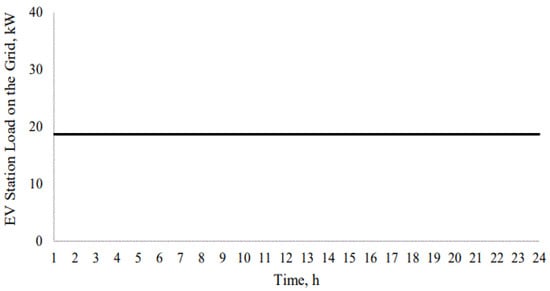
Figure 7.
EV charging station load profile on the grid considering 90% flexibility scenario.
The high variability profile (Figure 5) puts more strain on grid infrastructure due to high peaks and significant troughs, which require robust grid management systems and quick response capabilities to prevent outages. In contrast, the flat profile (Figure 7) is the most beneficial for grid management because it provides predictable loads and avoids placing additional stress during peak hours. It facilitates the easier integration of renewable energy sources, which often produces power at a constant rate. It can be noted that the moderate variability profile (Figure 6) offers a balance by reducing loads during typically low-demand periods, which can help in managing overall energy efficiency and reducing the need for expensive peak power supplies.
The shape and magnitude of EV charging profiles impact not only the operational costs and efficiency of the grid but also its stability and capacity to integrate renewable sources. A flat load profile, while potentially underutilizing capacity during low-demand periods, provides the most stability. In contrast, more variable profiles, while potentially maximizing station throughput, require more complex and costly grid management strategies. Each profile has its trade-offs and must be selected based on broader energy management goals, infrastructure capabilities, and the typical patterns of EV usage in the area.
Table 1 summarizes the relationship between flexibility levels, peak load, and load variability in an EV charging system. At 0% flexibility, the system experiences a high peak load of 188 kW and significant variability, leading to considerable grid stress. With 50% flexibility, the peak load reduces to 94 kW, and variability decreases to a moderate level, offering a balanced approach to grid management. At 90% flexibility, the system achieves a constant load profile, with the peak load dropping to just 19 kW, resulting in minimal grid stress and highly predictable energy demand. This table highlights the effectiveness of increasing flexibility in reducing peak loads and controlling variability, demonstrating its potential to optimize system performance.

Table 1.
Impact of flexibility levels on peak load and load variability in EV charging system.
4. Conclusions
This paper presented a new framework for transforming conventional EV charging stations into energy hubs, offering a practical solution to the challenges of integrating renewable energy, managing peak loads, and enhancing grid flexibility. By developing a mixed-integer linear programming optimization model, this research provided a robust approach to optimize the sizing and operation of PV systems and BESS. The proposed model successfully minimized capacity requirements while maintaining operational efficiency, demonstrating its potential to reduce grid dependency and operational costs. The analysis of different flexibility scenarios revealed significant insights into the trade-offs between grid reliance and infrastructure investment. The results showed that higher flexibility levels lead to reduced grid strain, better utilization of renewable energy, and enhanced energy management. It also emphasizes that energy hubs, when designed and operated effectively, can act as critical nodes in achieving sustainable energy systems. This study highlighted the transformative potential of energy hubs in modern energy systems, aligning with global efforts toward decarbonization and smart grid development. The proposed energy hub framework not only supports the growth of electric mobility but also contributes to the broader goals of energy transition and sustainability. This work serves as a foundation for advancing EV infrastructure; promoting renewable energy adoption; and developing resilient, cost-efficient smart grids for the future.
Author Contributions
Conceptualization, W.A., F.A. and K.A.; methodology, W.A., F.A. and K.A.; software, W.A.; validation, W.A. and K.A.; formal analysis, W.A. and F.A.; investigation, W.A. and K.A.; resources, H.M.H.F. and A.A.A.-S.; data curation, W.A. and K.A.; writing—original draft preparation, W.A., F.A. and K.A.; writing—review and editing, W.A. and F.A.; visualization, F.A. and K.A.; supervision, W.A.; project administration, W.A.; funding acquisition, F.A. All authors have read and agreed to the published version of the manuscript.
Funding
This research was supported and funded by the Deanship of Scientific Research at Imam Mohammad Ibn Saud Islamic University (IMSIU) (grant number IMSIU-RG23092).
Data Availability Statement
The original contributions presented in the study are included in the article. Further inquiries can be directed to the corresponding author.
Conflicts of Interest
The authors declare no conflicts of interest.
References
- Saudi Vision 2030. Available online: https://www.vision2030.gov.sa/en (accessed on 10 April 2024).
- Alharbi, W.; Bhattacharya, K. Incentive design for flexibility provisions from residential energy hubs in smart grid. IEEE Trans. Smart Grid 2021, 12, 2113–2124. [Google Scholar] [CrossRef]
- Alharbi, W.; Bhattacharya, K. Electric Vehicle Charging Facility as a Smart Energy Microhub. IEEE Trans. Sustain. Energy 2017, 8, 616–628. [Google Scholar] [CrossRef]
- Habib, S.; Khan, M.M.; Abbas, F.; Numan, M.; Ali, Y.; Tang, H.; Yan, X. A framework for stochastic estimation of electric vehicle charging behavior for risk assessment of distribution networks. Front. Energy 2020, 14, 298–317. [Google Scholar] [CrossRef]
- Aboshady, F.M.; Pisica, I.; Axon, C.J. A stochastic model for estimating electric vehicle arrival at multi-charger forecourts. Energy Rep. 2022, 8, 11569–11578. [Google Scholar] [CrossRef]
- Faridimehr, S.; Venkatachalam, S.; Chinnam, R.B. A Stochastic Programming Approach for Electric Vehicle Charging Network Design. IEEE Trans. Intell. Transp. Syst. 2019, 20, 1870–1882. [Google Scholar] [CrossRef]
- Tao, S.; Liao, K.; Xiao, X.; Wen, J.; Yang, Y.; Zhang, J. Charging demand for electric vehicle based on stochastic analysis of trip chain. IET Gener. Transm. Distrib. 2016, 10, 2689–2698. [Google Scholar] [CrossRef]
- Pashajavid, E.; Golkar, M.A. Charging of plug-in electric vehicles: Stochastic modelling of load demand within domestic grids. In Proceedings of the 20th Iranian Conference on Electrical Engineering (ICEE2012), Tehran, Iran, 15–17 May 2012; pp. 535–539. [Google Scholar] [CrossRef]
- Bi, X.; Chipperfield, A.; Tang, W.K. Coordinating Electric Vehicle Flow Distribution and Charger Allocation by Joint Optimization. IEEE Trans. Ind. Inform. 2021, 17, 8112–8121. [Google Scholar] [CrossRef]
- Gan, L.; Topcu, U.; Low, S.H. Optimal decentralized protocol for electric vehicle charging. IEEE Trans. Power Syst. 2013, 28, 940–951. [Google Scholar] [CrossRef]
- Hung, Y.C.; Lok, H.P.; Michailidis, G. Optimal routing for electric vehicle charging systems with stochastic demand: A heavy traffic approximation approach. Eur. J. Oper. Res. 2022, 299, 526–541. [Google Scholar] [CrossRef]
- Ivarsøy, E.; Torsæter, B.N.; Korpås, M. Stochastic Load Modeling of High-Power Electric Vehicle Charging—A Norwegian Case Study. In Proceedings of the 2020 International Conference on Smart Energy Systems and Technologies (SEST), Istanbul, Turkey, 7–9 September 2020. [Google Scholar]
- Irshad, U.B.; Rafique, S.; Town, G. Stochastic modelling of electric vehicle behaviour to estimate available energy storage in parking lots. IET Smart Grid 2020, 3, 760–767. [Google Scholar] [CrossRef]
- Yan, D.; Ma, C. Stochastic planning of electric vehicle charging station integrated with photovoltaic and battery systems. IET Gener. Transm. Distrib. 2020, 14, 4217–4224. [Google Scholar] [CrossRef]
- Gholinejad, H.R.; Adabi, J.; Marzband, M. Hierarchical energy management system for home-energy-hubs considering plug-in electric vehicles. IEEE Trans. Ind. Appl. 2022, 58, 5582–5592. [Google Scholar] [CrossRef]
- Moeini-Aghtaie, M.; Abbaspour, A.; Fotuhi-Firuzabad, M.; Dehghanian, P. Optimized probabilistic PHEVs demand management in the context of energy hubs. IEEE Trans. Power Deliv. 2014, 30, 996–1006. [Google Scholar] [CrossRef]
- Moeini-Aghtaie, M.; Dehghanian, P.; Davoudi, M. Energy management of plug-in hybrid electric vehicles in renewable-based energy hubs. Sustain. Energy Grids Netw. 2022, 32, 100932. [Google Scholar] [CrossRef]
- Bartolucci, L.; Cordiner, S.; Mulone, V.; Santarelli, M.; Lombardi, P.; Wenge, C.; Arendarski, B.; Komarnicki, P. Grid service potential from optimal sizing and scheduling the charging hub of a commercial Electric Vehicle fleet. In Proceedings of the 2020 IEEE International Conference on Environment and Electrical Engineering and 2020 IEEE Industrial and Commercial Power Systems Europe (EEEIC/I&CPS Europe), Madrid, Spain, 9–12 June 2020; pp. 1–6. [Google Scholar]
- Haupt, L.; Schöpf, M.; Wederhake, L.; Weibelzahl, M. The influence of electric vehicle charging strategies on the sizing of electrical energy storage systems in charging hub microgrids. Appl. Energy 2020, 273, 115231. [Google Scholar] [CrossRef]
- Kazemi, B.; Kavousi-Fard, A.; Dabbaghjamanesh, M.; Karimi, M. IoT-enabled operation of multi energy hubs considering electric vehicles and demand response. IEEE Trans. Intell. Transp. Syst. 2022, 24, 2668–2676. [Google Scholar] [CrossRef]
- George-Williams, H.; Wade, N.; Carpenter, R. A probabilistic framework for the techno-economic assessment of smart energy hubs for electric vehicle charging. Renew. Sustain. Energy Rev. 2022, 162, 112386. [Google Scholar] [CrossRef]
- Lin, H.; Liu, Y.; Sun, Q.; Xiong, R.; Li, H.; Wennersten, R. The impact of electric vehicle penetration and charging patterns on the management of energy hub—A multi-agent system simulation. Appl. Energy 2018, 230, 189–206. [Google Scholar] [CrossRef]
- Aslani, M.; Mashayekhi, M.; Hashemi-Dezaki, H.; Ketabi, A. Robust optimal operation of energy hub incorporating integrated thermal and electrical demand response programs under various electric vehicle charging modes. Appl. Energy 2022, 321, 119344. [Google Scholar] [CrossRef]
- Xylia, M.; Leduc, S.; Patrizio, P.; Kraxner, F.; Silveira, S. Locating charging infrastructure for electric buses in Stockholm. Transp. Res. Part C Emerg. Technol. 2017, 78, 183–200. [Google Scholar] [CrossRef]
- GAMS Development Corporation. General Algebraic Modeling System (GAMS), Software. Available online: https://http://www.gams.com (accessed on 4 May 2024).
- Baran, M.E.; Wu, F.F. Network reconfiguration in distribution systems for loss reduction and load balancing. IEEE Power Eng. Rev. 1989, 9, 101–102. [Google Scholar] [CrossRef]
- Pinheiro, J.; Dornellas, C.; Schilling, M.T.; Melo, A.; Mello, J. Probing the new IEEE reliability test system (RTS-96): HL-II assessment. IEEE Trans. Power Syst. 1998, 13, 171–176. [Google Scholar] [CrossRef]
- U.S. Department of Transportation. National Household Travel Survey. Available online: http://nhts.ornl.gov (accessed on 5 April 2024).
- Alfraidi, W.; Shalaby, M.; Alaql, F. Modeling EV charging station loads considering on-road wireless charging capabilities. World Electr. Veh. J. 2023, 14, 313. [Google Scholar] [CrossRef]
Disclaimer/Publisher’s Note: The statements, opinions and data contained in all publications are solely those of the individual author(s) and contributor(s) and not of MDPI and/or the editor(s). MDPI and/or the editor(s) disclaim responsibility for any injury to people or property resulting from any ideas, methods, instructions or products referred to in the content. |
© 2025 by the authors. Published by MDPI on behalf of the World Electric Vehicle Association. Licensee MDPI, Basel, Switzerland. This article is an open access article distributed under the terms and conditions of the Creative Commons Attribution (CC BY) license (https://creativecommons.org/licenses/by/4.0/).